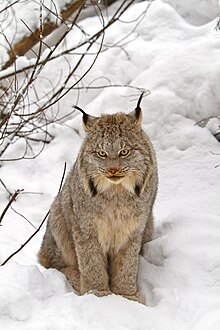Canadian lynx
| Canada lynx | |
|---|---|
 |
|
| Scientific classification | |
| Kingdom: | Animalia |
| Phylum: | Chordata |
| Clade: | Synapsida |
| Class: | Mammalia |
| Order: | Carnivora |
| Family: | Felidae |
| Subfamily: | Felinae |
| Genus: | Lynx |
| Species: | L. canadensis |
| Binomial name | |
|
Lynx canadensis Kerr, 1792 |
|
 |
|
| Canada lynx range | |
| Synonyms | |
|
|
The Canada lynx (Lynx canadensis) or Canadian lynx is a North American mammal of the cat family, Felidae. With the recognised subspecies, it ranges across Canada and into Alaska as well as some parts of the northern United States.
With a dense silvery-brown coat, ruffed face and tufted ears, the Canada lynx resembles the other species of the mid-sized Lynx genus. It is slightly larger than the bobcat, with which it shares parts of its range, and over twice the size of the domestic cat.
The Canada lynx is one of the four members of the genus Lynx, and is classified under the family Felidae. It was first described by scientific writer Robert Kerr in his 1792 work The Animal Kingdom as Felis lynx canadensis. The taxonomy of lynxes has remained in dispute; it is not even clear if Lynx should be considered an independent genus or a subgenus of Felis. Even the status of the Canada lynx as an independent species is doubted by some authorities. For instance, Renn Tumlinson considers the Canada lynx as a subspecies of the Eurasian lynx (L. lynx) in his 1987 account of the Eurasian lynx in Mammalian Species. However, some authorities like zoologist W. Christopher Wozencraft, who revised the classification of carnivorans in 1989 and 1993, consider the two to be separate species.
According to a 2006 study based on genetic analysis, the ancestor of five felid lineages – Lynx, Leopardus, Puma, Felis and Prionailurus plus – arrived in North America after crossing the Bering Strait 8.5–8 mya. Lynx diverged from the Puma, Felis and Prionailurus plus Otocolobus lineages around 3.24 mya. The Issoire lynx (L. issiodorensis), that probably originated in Africa 4 mya and occurred in Europe and northern Asia until it became extinct around 1 mya, is believed to be the ancestor of the four modern species of Lynx. A 1987 study suggested that the populations of the Eurasian lynx that reached North America 20,000 years ago initially moved toward the southern half of the continent, as the northern part was covered by glaciers. The southern populations gradually evolved into the modern bobcat (L. rufus). Later, when the continent was invaded by the Eurasian lynx for a second time, the populations that settled in the northern part of the continent, now devoid of glaciers, evolved into the Canadian lynx. The 2006 study gave the phylogenetic relationships of the Canada lynx as follows:
...
Wikipedia

